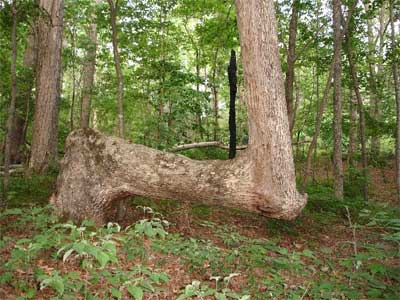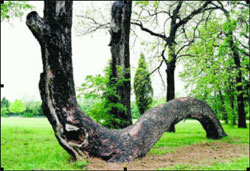Texas Tree Tips – April, 2011

This Cherokee Marker Tree exhibits the typical slight bend low on the trunk (near the ground) and a second sharp bend upward. Photo courtesy of the Mountain Stewards.
Indian Marker Trees
Historically, living in complete harmony with nature has been a way of life for Native Americans. They relied on Nature for all their needs. Many years ago, traveling from place to place required good navigational skills, directions along the way, and a method to mark common trails. Native Americans used trees not only to mark a trail, but also to signal the presence of important features, some of which were critical for survival.
Today, some call these old road signs Indian marker trees. They are known by others as trail trees, thong trees, or culturally modified trees. Years ago, Linda Pelon, one of the first anthropologists researching the subject, taught me the term Indian marker tree. I will stick with this name.
An Indian marker tree is a tree that was purposely bent over as a sapling and held in a bent position throughout most of its young life. The trees were tied down using a thong of animal hide, which is where the name “thong tree” originated. They were used to guide the Native Americans to a source of water, a good place to cross a river, a campsite or other important natural features. To those who could interpret their meaning, they were similar to a life-saving road sign. However, I doubt there was one for “rest stop.”
Why are most folks not aware that Indian marker trees exist? Many years ago, the Native Americans were not fond of explaining all the details regarding their way of life to outsiders. They always saw the need to live within the balance of nature and had a great reverence for all the glorious things that nature provided. They were the ultimate stewards of our natural world, whereas the “white man” only saw endless opportunity. “White man look — but not see.”
Indian marker trees are the living witnesses to the history of a past civilization and their incredible way of life. These trees are a significant part of this nation’s cultural heritage and a gift to our current society. They provide lessons about our past and lessons yet to be learned, but their life expectancy is limited. This underscores an urgency to study and document as much information as we can about those trees that do exist. A number of suspected Indian marker trees in the DFW area are currently being researched, and more details are expected in the future.
A very inspired group of volunteers known as the “Mountain Stewards” have documented literally thousands of Cherokee Indian marker trees in the Southern Appalachian Mountains. They have created trail maps, presentations, and completed a soon-to-be-released book on their research. The organization’s president, Donald Wells, is an outstanding source of information and support for our regional research.
Although the exact shape and tree species may vary, the Cherokees had a different way of shaping a marker tree than the typical Comanche marker tree found in the DFW area. Most all trees found by the Mountain Stewards are the Cherokee style, which has a slight bend low on the trunk (near the ground) and a second sharp bend upward.

Gateway Park Comanche Indian Marker Tree, recognized in 1996. Photo courtesy of Linda Pelon.
The typical Comanche-style Indian marker tree in North Texas has a trunk that is often described as a “half-moon,” which may touch the ground before growing upward.
Since there are different shapes for some tribes, the trees could have been used to mark tribal boundaries, signaling other tribes to stay away — much like “no trespassing” signs. You trespass … you get a Kickapoo.
Although there is enough documentation on Indian marker trees to more than verify and confirm their existence, skeptics remain. More on that next month.
These articles are written out of profound respect for our Native Americans as the greatest stewards our lands will ever know, and as a way to honor those who are “One with Nature,” according to Comanche Tribal Elder, James Yellowfish.
About the author: Steve Houser is a Dallas native with more than 30 years of experience as a consulting arborist and tree climber. He is the president of Arborilogical Services Inc., “The Experts Your Trees Deserve.” www.arborilogical.com.

